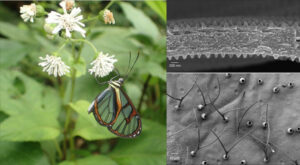Clearwing butterflies: hidden and visible at the same time – Human Frontier Science Program

Distasteful butterflies and moths typically harbor vividly colored and contrasted wing patterns, which are efficiently learned by predators. Surprisingly, some of those species have partially transparent wings, a feature that has previously been shown to reduce detectability by predators. This study uncovers a surprising diversity of structures generating transparency in different butterfly and moth species and reveals that the optical characteristics of the transparent areas also contribute, along with the colored elements, to predators’ learning.
Caption: The clearwing butterfly species Ithomia diasia (left) is distasteful. Wing transparency is primarily generated by the reduction of scales’ width (bottom right: forked hair-looking scales), and is further enhanced by the presence of nanoprotuberances on the wing membrane (top right). Photo credits: Marianne Elias (butterfly photo), Stephan Borensztajn (microscopy images).
|
HFSP award information Research Grant – Program (RGP0014/2016): Development, functions, and evolution of transparency in butterflies: an interdisciplinary approach Principal investigator: Marianne Elias, Institute of Systematics and Evolution of Biodiversity, Paris, France |
Reference
Mimicry can drive convergence in structural and light transmission features of transparent wings in Lepidoptera.
Pinna C, Vilbert M, Borensztajn S, Daney de Marcillac W, Piron-Prunier F, Pomerantz AF, Patel N, Berthier S, Andraud C, Gomez D*, Elias M*. 2021. eLife, 10:e69080. 10.7554/eLife.69080 *equal contributions
https://elifesciences.org/articles/69080

